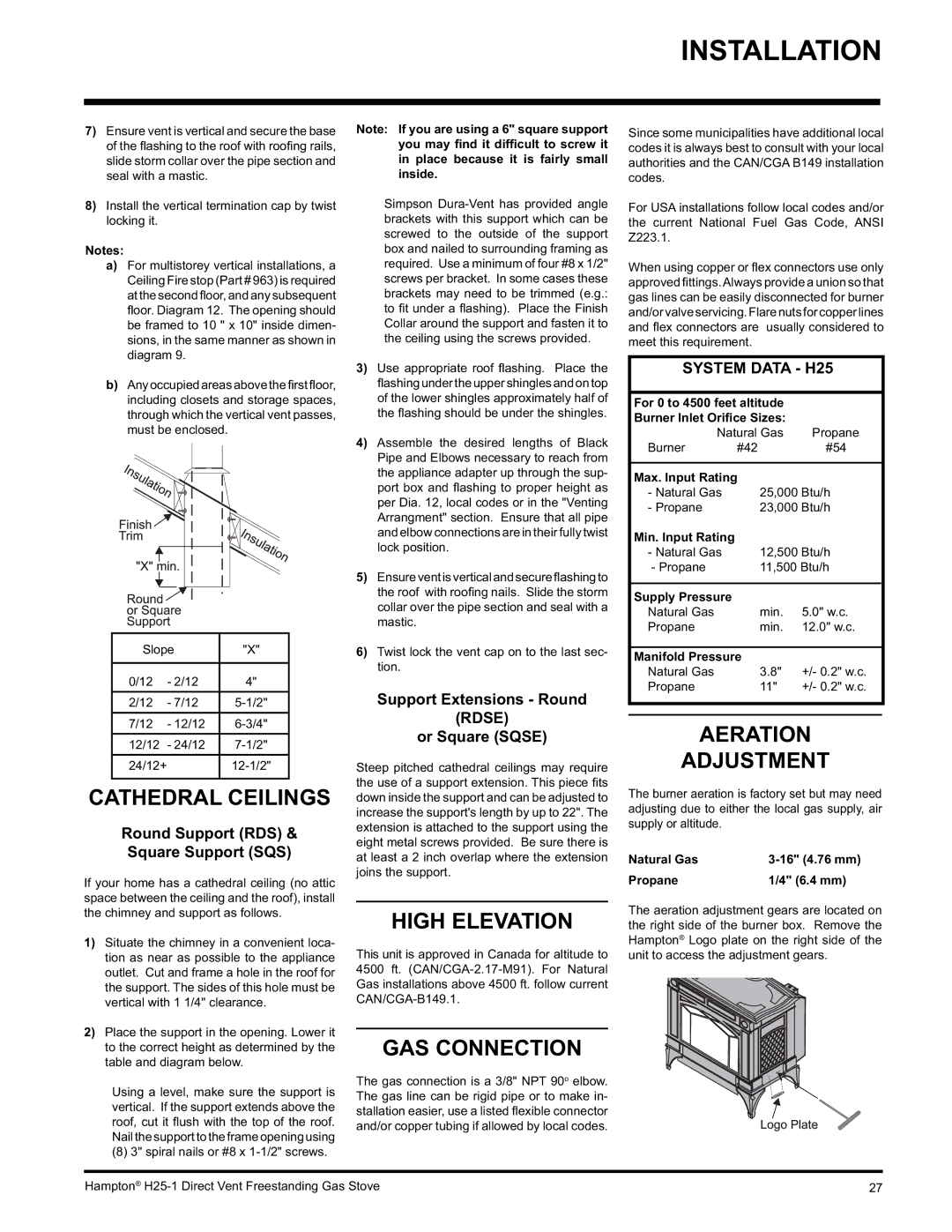7)Ensure vent is vertical and secure the base of the fl ashing to the roof with roofi ng rails, slide storm collar over the pipe section and seal with a mastic.
8)Install the vertical termination cap by twist locking it.
Notes:
a)For multistorey vertical installations, a Ceiling Fire stop (Part # 963) is required at the second floor, and any subsequent fl oor. Diagram 12. The opening should be framed to 10 " x 10" inside dimen- sions, in the same manner as shown in diagram 9.
b)Any occupied areas above the first floor, including closets and storage spaces, through which the vertical vent passes, must be enclosed.
Slope | "X" |
| | |
0/12 | - 2/12 | 4" |
2/12 | - 7/12 | 5-1/2" |
7/12 | - 12/12 | 6-3/4" |
12/12 | - 24/12 | 7-1/2" |
24/12+ | | 12-1/2" |
| | |
CATHEDRAL CEILINGS
Round Support (RDS) &
Square Support (SQS)
If your home has a cathedral ceiling (no attic space between the ceiling and the roof), install the chimney and support as follows.
1)Situate the chimney in a convenient loca- tion as near as possible to the appliance outlet. Cut and frame a hole in the roof for the support. The sides of this hole must be vertical with 1 1/4" clearance.
2)Place the support in the opening. Lower it to the correct height as determined by the table and diagram below.
Using a level, make sure the support is vertical. If the support extends above the roof, cut it fl ush with the top of the roof. Nail the support to the frame opening using
(8) 3" spiral nails or #8 x 1-1/2" screws.
Note: If you are using a 6" square support you may find it difficult to screw it in place because it is fairly small inside.
Simpson Dura-Vent has provided angle brackets with this support which can be screwed to the outside of the support box and nailed to surrounding framing as required. Use a minimum of four #8 x 1/2" screws per bracket. In some cases these brackets may need to be trimmed (e.g.: to fi t under a fl ashing). Place the Finish Collar around the support and fasten it to the ceiling using the screws provided.
3)Use appropriate roof fl ashing. Place the flashing under the upper shingles and on top of the lower shingles approximately half of the fl ashing should be under the shingles.
4)Assemble the desired lengths of Black Pipe and Elbows necessary to reach from the appliance adapter up through the sup- port box and fl ashing to proper height as per Dia. 12, local codes or in the "Venting Arrangment" section. Ensure that all pipe and elbow connections are in their fully twist lock position.
5)Ensureventisverticalandsecureflashingto the roof with roofi ng nails. Slide the storm collar over the pipe section and seal with a mastic.
6)Twist lock the vent cap on to the last sec- tion.
Support Extensions - Round
(RDSE)
or Square (SQSE)
Steep pitched cathedral ceilings may require the use of a support extension. This piece fi ts down inside the support and can be adjusted to increase the support's length by up to 22". The extension is attached to the support using the eight metal screws provided. Be sure there is at least a 2 inch overlap where the extension joins the support.
HIGH ELEVATION
This unit is approved in Canada for altitude to 4500 ft. (CAN/CGA-2.17-M91). For Natural Gas installations above 4500 ft. follow current CAN/CGA-B149.1.
GAS CONNECTION
The gas connection is a 3/8" NPT 90o elbow. The gas line can be rigid pipe or to make in- stallation easier, use a listed fl exible connector and/or copper tubing if allowed by local codes.
Since some municipalities have additional local codes it is always best to consult with your local authorities and the CAN/CGA B149 installation codes.
For USA installations follow local codes and/or the current National Fuel Gas Code, ANSI Z223.1.
When using copper or fl ex connectors use only approved fi ttings.Always provide a union so that gas lines can be easily disconnected for burner and/or valve servicing. Flare nuts for copper lines and fl ex connectors are usually considered to meet this requirement.
SYSTEM DATA - H25
For 0 to 4500 feet altitude | | |
Burner Inlet Orifice Sizes: | | |
Natural Gas | Propane |
Burner | #42 | | #54 | |
| | | |
Max. Input Rating | | | |
- Natural Gas | | 25,000 Btu/h |
- Propane | | 23,000 Btu/h |
Min. Input Rating | | | | |
- Natural Gas | | 12,500 Btu/h |
- Propane | | 11,500 Btu/h |
| | | | |
Supply Pressure | | | | |
Natural Gas | | min. | 5.0" w.c. |
Propane | | min. | 12.0" w.c. |
| | | |
Manifold Pressure | | | |
Natural Gas | | 3.8" | +/- 0.2" w.c. |
Propane | | 11" | +/- 0.2" w.c. |
AERATION
ADJUSTMENT
The burner aeration is factory set but may need adjusting due to either the local gas supply, air supply or altitude.
Natural Gas | 3-16" (4.76 mm) |
Propane | 1/4" (6.4 mm) |
The aeration adjustment gears are located on the right side of the burner box. Remove the Hampton® Logo plate on the right side of the unit to access the adjustment gears.

